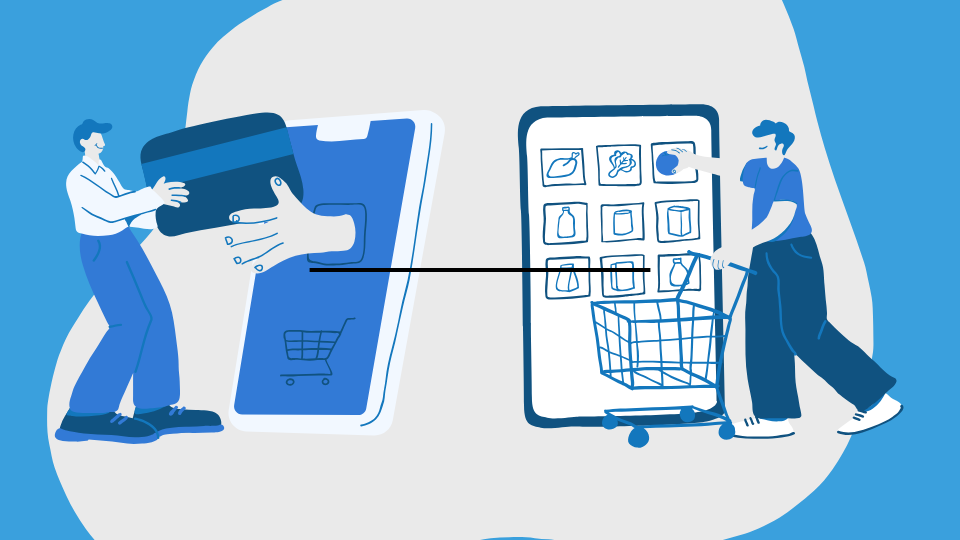E-commerce is rapidly evolving, with global e-commerce sales projected to grow by 39% by 2027. As technology advances and consumer expectations shift, businesses must stay ahead of emerging trends to remain competitive. For those considering online marketplace development, understanding these trends is crucial for creating platforms that meet modern consumer needs. From augmented reality (AR) enhancing the online shopping experience to voice search transforming how customers find products, e-commerce trends are filled with innovation. In this article, we explore the top trends shaping the industry in 2024 and how businesses can leverage these changes to drive growth and improve customer engagement.
What Are Emerging E-Commerce Trends in 2024?
Emerging e-commerce trends in 2024 are transforming how businesses operate and engage with customers. Innovations like augmented reality, voice search, and AI-driven personalization are transforming online shopping. At the same time, mobile commerce and sustainability are shaping evolving consumer preferences. These trends are crucial for businesses to stay competitive in the evolving digital landscape.
Augmented Reality as An E-Commerce Trend

Augmented reality (AR) is transforming the e-commerce experience by allowing customers to visualize products in their real-world environments before purchasing. With AR, shoppers can see how a sofa fits in their living room or how sunglasses look on their face.
This technology boosts buyer confidence and reduces return rates by providing a more informed shopping experience. As AR adoption grows, especially with over 100 million users expected in the US by 2025, it’s becoming a key tool for bridging the gap between digital and physical retail.
A fashion retailer can use augmented reality (AR) by offering virtual try-ons for customers. This allows shoppers to see how clothing or accessories, like sunglasses, look before purchasing. This feature enhances the shopping experience by boosting buyer confidence. It also reduces returns as customers make more informed decisions about fit and style.
E-Commerce Trend: Livestream Shopping
Livestream shopping is a rising trend that blends real-time video content with instant purchasing options. Through platforms like Instagram and TikTok, influencers and brand representatives demonstrate products live, answering questions and interacting with viewers. This adds a dynamic, human touch to online shopping, creating urgency and excitement that drives immediate sales.
As social commerce continues to grow, particularly among younger consumers, livestream shopping is no longer a trend but it is becoming an integral part of e-commerce strategies.
A beauty brand can use livestream shopping by hosting live product demos on Instagram or TikTok. During these sessions, influencers or brand representatives showcase makeup products in real-time. This approach creates a dynamic, interactive experience for potential customers.
During the stream, viewers can ask questions, see live tutorials, and instantly purchase the featured items through clickable links. This interactive approach boosts engagement, creates a sense of urgency, and drives immediate sales, particularly among younger, social media-savvy shoppers.
Read More: How to Optimize a Website: A Step-by-Step Guide
User-Generated Content (UGC) Drives Authenticity

User-generated content, such as reviews, social media posts, short-form content, and customer photos, is a powerful tool in e-commerce marketing. Consumers trust personal recommendations more than traditional advertising, and UGC provides social proof that influences buying decisions.
Brands that leverage UGC can enhance product visibility, boost engagement, and cultivate loyalty by showcasing real customer experiences.
A skincare brand can encourage customers to share photos and reviews on social media by offering incentives. These incentives might include discounts or featuring customer posts on the brand’s website and Instagram page.
By showcasing user-generated content (UGC), the brand builds trust and credibility. This strategy motivates potential buyers to purchase based on real customer experiences.
Omnichannel Experiences Enhance Customer Satisfaction
Omnichannel marketing connect online and offline shopping, creating a seamless brand experience for customers. This approach allows engagement across websites, mobile apps, social media, and physical stores effortlessly.
This unified approach is essential for meeting modern consumers’ expectations for personalized, efficient shopping. By integrating customer interactions across platforms, businesses can increase satisfaction, loyalty, and sales while gathering valuable data on consumer behavior.
A fashion retailer can use an omni-channel strategy by letting customers browse online, buy via a mobile app, and pick up in-store. By connecting these channels, customers easily switch between online and offline experiences.
They can check in-store product availability or receive personalized recommendations based on past purchases. This unified approach improves customer satisfaction, enhances loyalty, and provides valuable insights into shopping behaviors across platforms.
Read More: Impact of Negative Reviews on Businesses and How to Alleviate It with Brand Editorial Reviews
Voice Search Is on the Rise
Voice search is expected to grow as more consumers rely on smart speakers like Amazon Alexa and Google Assistant. The convenience of using voice commands for product searches, price comparisons, and purchases is transforming how people shop online.
To stay competitive, e-commerce businesses must optimize content for voice search. They should focus on conversational, long-tail keywords that match natural speech patterns. This ensures better visibility in voice-based queries.
An online grocery store can use voice search by optimizing its website for smart speakers like Amazon Alexa. Customers can use voice commands to search for products or add items to their cart.
By focusing on conversational, long-tail keywords like “order fresh organic apples,” the store ensures products are easily found through voice queries. This makes shopping more convenient and helps the business stay competitive in the growing voice search market.
E-Commerce Trend: Personalization and Upselling Using AI
Another hot e-commerce trend is artificial intelligence (AI) marketing. It is revolutionizing how e-commerce businesses interact with customers. By analyzing shopping behaviors and preferences, AI provides personalized product recommendations, predicts consumer needs, and improves customer service through AI-driven chatbots.
This technology also enables businesses to optimize their supply chains, increase upselling and cross-selling opportunities, and streamline operations, ultimately boosting customer satisfaction and sales.
An online electronics retailer can use AI to analyze customer browsing and purchase histories, providing personalized product recommendations, such as suggesting accessories for a recently bought smartphone.
By leveraging AI-driven chatbots, the retailer can offer real-time assistance and upsell complementary products during the shopping experience. This approach enhances customer satisfaction while increasing upselling opportunities and overall sales.
E-Commerce Trend: Mobile Shopping Continues to Grow

Mobile commerce is on the rise, with a projected 62% of all e-commerce sales coming from mobile devices by 2027. Consumers expect fast, seamless experiences on their smartphones, so businesses must optimize their websites and apps for mobile use. Features like one-click ordering, responsive design, and easy navigation are crucial for capturing the growing mobile shopper segment.
A clothing retailer can do mobile optimization by implementing a responsive design that adjusts seamlessly to smartphones and tablets. Offering features like one-click ordering and streamlined navigation will make the shopping experience fast and hassle-free, catering to the growing number of mobile shoppers. This mobile-friendly approach helps capture more sales and improves overall customer satisfaction.
More Payment Options Increase Conversions
Offering a variety of payment options is essential for reducing cart abandonment and increasing conversions. Alongside traditional credit cards, e-commerce platforms now support digital wallets like Apple Pay, Google Wallet, and even cryptocurrencies.
Additionally, flexible payment methods such as buy now, pay later (BNPL) options are gaining popularity, giving customers more freedom and improving the overall shopping experience.
An online fashion retailer can incorporate more payment options by offering digital wallets like Apple Pay, Google Wallet, and cryptocurrencies, alongside traditional credit cards. Additionally, by integrating buy now, pay later (BNPL) options such as Klarna or Affirm, the retailer allows customers to pay in installments, making high-value purchases more accessible.
This variety of payment choices reduces cart abandonment and improves conversion rates by providing greater flexibility for customers.
Read More: User Feedback Analysis: How to Do It
Headless and API-Driven E-Commerce Accelerates Innovation
Headless commerce separates the front-end shopping interface from the back-end infrastructure, enabling businesses to innovate faster. By leveraging APIs, companies can integrate new features like advanced search functions or personalized marketing tactics without reworking the entire system.
Additionally, this approach provides greater flexibility, allowing e-commerce businesses to quickly adapt to new trends and consumer needs.
A beauty brand can adopt a headless commerce approach by using APIs to integrate new features, such as personalized skincare recommendations and advanced search filters, into their website without altering the back-end system.
This flexibility allows the business to quickly roll out innovations, like dynamic marketing campaigns or customized user experiences, while keeping the infrastructure stable. As a result, the brand can swiftly respond to evolving customer preferences and market trends.
Video Content Boosts Engagement
Video content is increasingly influential in e-commerce, offering customers a richer, more engaging way to learn about products. Whether it’s tutorials, product demos, or customer testimonials, videos can enhance understanding and confidence in purchase decisions.
As a result, more online retailers are incorporating videos into their product pages and marketing strategies to drive conversions.
A home appliance retailer can incorporate video content by adding product demo videos and customer testimonials to its product pages.
These videos can showcase how appliances work, highlight key features, and provide real-life user experiences, helping customers better understand the products. This engaging content builds confidence in purchase decisions and can significantly boost conversions.
Subscription Models Encourage Customer Retention

Subscription models continue to grow across various industries, offering recurring revenue streams and fostering long-term customer relationships. Businesses that provide subscription services often pair them with exclusive perks, such as discounts or early access to new products, enhancing customer loyalty.
This approach simplifies the shopping process, making it easier for customers to receive regular shipments and increasing retention rates.
A coffee company can incorporate a subscription model by offering customers the option to receive their favorite coffee blends delivered monthly. Moreover, by providing subscribers with perks like discounts, early access to new flavors, or exclusive limited-edition products, the company fosters loyalty and builds long-term relationships.
This recurring service simplifies the buying process, ensuring consistent revenue and increased customer retention.
Sustainability Gains Importance
Sustainability is becoming a top priority for consumers, with over 70% of shoppers willing to pay more for eco-friendly products. E-commerce businesses are responding by offering sustainable goods, adopting transparent supply chain practices, and reducing packaging waste.
This shift not only meets consumer demands but also helps businesses build brand loyalty and improve their reputation in a market where sustainability is a key differentiator.
A fashion retailer can incorporate sustainability by offering eco-friendly clothing made from organic materials and using minimal, recyclable packaging for shipments.
By transparently sharing their sustainable sourcing practices and reducing their carbon footprint, the retailer can appeal to environmentally-conscious consumers. This focus on sustainability not only meets growing customer demand but also strengthens brand loyalty and enhances the retailer’s reputation in a competitive market.
Conversion Optimization is Essential for Growth
Optimizing digital strategies to improve conversion rates is critical for e-commerce success. Businesses should focus on enhancing website design, streamlining checkout processes, and leveraging data-driven personalization to make the shopping experience smoother and more appealing.
By prioritizing conversion rate optimization, companies can increase revenue, customer satisfaction, and overall competitiveness in the digital landscape.
An online electronics retailer can improve conversion rates by simplifying its checkout process, offering one-click purchasing options, and using data-driven personalization to recommend relevant products.
By optimizing the website for speed and ease of use, the retailer ensures a smooth shopping experience that reduces cart abandonment. These conversion optimization strategies increase customer satisfaction, leading to higher sales and improved competitiveness.
Frequently Asked Questions
Why is augmented reality important for e-commerce in 2024?
How does livestream shopping benefit online retailers?
What role does user-generated content play in e-commerce?
Why is offering multiple payment options important?
How does sustainability influence e-commerce success?
Conclusion
In conclusion, emerging e-commerce trends for 2024, such as augmented reality, voice search, and AI-driven personalization, are transforming the future of online shopping. To remain competitive, businesses should adopt these innovations to enhance customer experiences and drive growth. For expert guidance in leveraging these trends, reach out to LeadAdvisors and ensure your brand’s long-term success in the evolving digital landscape.












